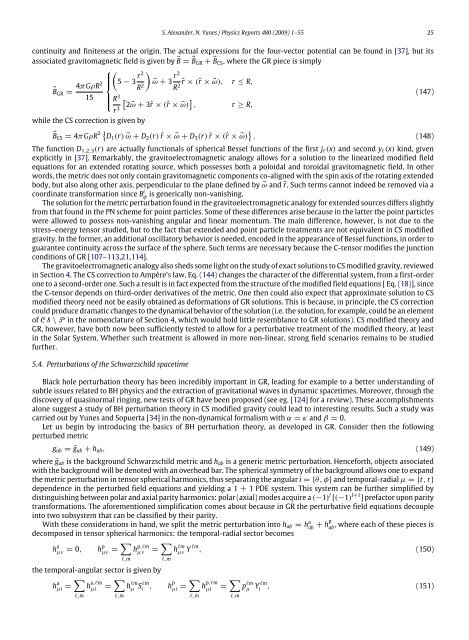Physics Reports ChernâSimons modified general relativity
Physics Reports ChernâSimons modified general relativity
Physics Reports ChernâSimons modified general relativity
Create successful ePaper yourself
Turn your PDF publications into a flip-book with our unique Google optimized e-Paper software.
S. Alexander, N. Yunes / <strong>Physics</strong> <strong>Reports</strong> 480 (2009) 1–55 25continuity and finiteness at the origin. The actual expressions for the four-vector potential can be found in [37], but itsassociated gravitomagnetic field is given by B ⃗ = BGR ⃗ + BCS ⃗ , where the GR piece is simply⎧⎪⎨(5 − 3 r )2⃗ω + 3 r 2ˆr × (ˆr × ⃗ω), r ≤ R,⃗B GR = 4πGρR2 R 2 R2 (147)15 ⎪⎩ R 3 [ ]2⃗ω + 3ˆr × (ˆr × ⃗ω) , r ≥ R,r 3while the CS correction is given by⃗B CS = 4πGρR 2 { D 1 (r) ⃗ω + D 2 (r) ˆr × ⃗ω + D 3 (r) ˆr × (ˆr × ⃗ω) } . (148)The function D 1,2,3 (r) are actually functionals of spherical Bessel functions of the first j l (x) and second y l (x) kind, givenexplicitly in [37]. Remarkably, the gravitoelectromagnetic analogy allows for a solution to the linearized <strong>modified</strong> fieldequations for an extended rotating source, which possesses both a poloidal and toroidal gravitomagnetic field. In otherwords, the metric does not only contain gravitomagnetic components co-aligned with the spin axis of the rotating extendedbody, but also along other axis, perpendicular to the plane defined by ⃗ω and ⃗r. Such terms cannot indeed be removed via acoordinate transformation since B i φ is generically non-vanishing.The solution for the metric perturbation found in the gravitoelectromagnetic analogy for extended sources differs slightlyfrom that found in the PN scheme for point particles. Some of these differences arise because in the latter the point particleswere allowed to possess non-vanishing angular and linear momentum. The main difference, however, is not due to thestress–energy tensor studied, but to the fact that extended and point particle treatments are not equivalent in CS <strong>modified</strong>gravity. In the former, an additional oscillatory behavior is needed, encoded in the appearance of Bessel functions, in order toguarantee continuity across the surface of the sphere. Such terms are necessary because the C-tensor modifies the junctionconditions of GR [107–113,21,114].The gravitoelectromagnetic analogy also sheds some light on the study of exact solutions to CS <strong>modified</strong> gravity, reviewedin Section 4. The CS correction to Ampère’s law, Eq. (144) changes the character of the differential system, from a first-orderone to a second-order one. Such a result is in fact expected from the structure of the <strong>modified</strong> field equations [ Eq. (18)], sincethe C-tensor depends on third-order derivatives of the metric. One then could also expect that approximate solution to CS<strong>modified</strong> theory need not be easily obtained as deformations of GR solutions. This is because, in principle, the CS correctioncould produce dramatic changes to the dynamical behavior of the solution (i.e. the solution, for example, could be an elementof CS \ P in the nomenclature of Section 4, which would hold little resemblance to GR solutions). CS <strong>modified</strong> theory andGR, however, have both now been sufficiently tested to allow for a perturbative treatment of the <strong>modified</strong> theory, at leastin the Solar System. Whether such treatment is allowed in more non-linear, strong field scenarios remains to be studiedfurther.5.4. Perturbations of the Schwarzschild spacetimeBlack hole perturbation theory has been incredibly important in GR, leading for example to a better understanding ofsubtle issues related to BH physics and the extraction of gravitational waves in dynamic spacetimes. Moreover, through thediscovery of quasinormal ringing, new tests of GR have been proposed (see eg. [124] for a review). These accomplishmentsalone suggest a study of BH perturbation theory in CS <strong>modified</strong> gravity could lead to interesting results. Such a study wascarried out by Yunes and Sopuerta [34] in the non-dynamical formalism with α = κ and β = 0.Let us begin by introducing the basics of BH perturbation theory, as developed in GR. Consider then the followingperturbed metricg ab = ḡ ab + h ab , (149)where ḡ ab is the background Schwarzschild metric and h ab is a generic metric perturbation. Henceforth, objects associatedwith the background will be denoted with an overhead bar. The spherical symmetry of the background allows one to expandthe metric perturbation in tensor spherical harmonics, thus separating the angular i = {θ, φ} and temporal-radial µ = {t, r}dependence in the perturbed field equations and yielding a 1 + 1 PDE system. This system can be further simplified bydistinguishing between polar and axial parity harmonics: polar (axial) modes acquire a (−1) l [(−1) l+1 ] prefactor upon paritytransformations. The aforementioned simplification comes about because in GR the perturbative field equations decoupleinto two subsystem that can be classified by their parity.With these considerations in hand, we split the metric perturbation into h ab = h a + ab hp ab, where each of these pieces isdecomposed in tensor spherical harmonics: the temporal-radial sector becomesh a µν = 0,hp µν = ∑ l,mh p,lmµν = ∑ h lmµν Y lm , (150)l,mthe temporal-angular sector is given byh a µi = ∑ l,mh a,lmµi= ∑ h lmµ Slm i, h p = ∑ µih p,lmµi= ∑ p lmµ Y lmi, (151)l,ml,ml,m



![arXiv:1001.0993v1 [hep-ph] 6 Jan 2010](https://img.yumpu.com/51282177/1/190x245/arxiv10010993v1-hep-ph-6-jan-2010.jpg?quality=85)


![arXiv:1008.3907v2 [astro-ph.CO] 1 Nov 2011](https://img.yumpu.com/48909562/1/190x245/arxiv10083907v2-astro-phco-1-nov-2011.jpg?quality=85)







![arXiv:1002.4928v1 [gr-qc] 26 Feb 2010](https://img.yumpu.com/41209516/1/190x245/arxiv10024928v1-gr-qc-26-feb-2010.jpg?quality=85)
![arXiv:1206.2653v1 [astro-ph.CO] 12 Jun 2012](https://img.yumpu.com/39510078/1/190x245/arxiv12062653v1-astro-phco-12-jun-2012.jpg?quality=85)
